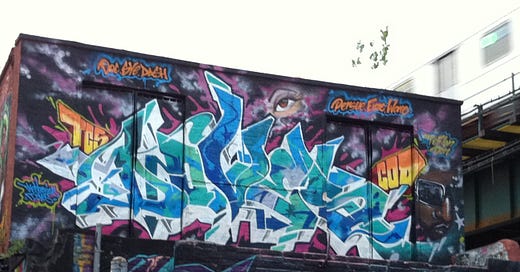Making Something Outta Nothing
Hip Hop, Graffiti and the Reclamation of Space and Material Culture (Part 2 of 5)
Acknowledgements
Thanks to Kilo…Sinstars FBA for kindly providing photographs. Peace to all the real writers worldwide, past, present and future, thank you for your love, your tenacity and your relentless efforts to paint the world.
Abstract
This article is the second part of a five-part inquiry in which I explore the origins of graffiti vis-à-vis the context of hip hop culture. Following on from part one, the structure of this second part explores the evolution of formative graffiti writing, its cultural narrative and spatio-material production. Additionally, the article begins to expose the relationship, empathies and synergies of formative graffiti writing with the elements of hip hop, hinting at the idea of a transdisciplinary spatio-metaphor and sense of intertextuality. It closes with a proposal that graffiti continually re-writes the city through a spatio-material palimpsest of sliding scales: the micro, macro, medium and transience.
Creativity and Invention
“Broken glass everywhere, people pissing on the stairs you know they just don’t care. I can’t take the smell, can’t take the noise, got no money to move out I guess I got no choice. Rats in the front room roaches in the back, junkies in the alley with a baseball bat…”
(Melle Mel in ‘The Message’, 1982)
“The South Bronx, at its moment of greatest misery and anguish, and in some sense because of its misery and anguish, created the mass culture called hip hop” (Berman 2007: 25). Within this destitute, ill-conceived and ignored urban condition, the evolution of hip hop culture was at its genesis. Unsurprisingly the youth of these ghettos felt abandoned, alienated and without any socio-spatial structure that they could identify with. The aesthetic that encapsulated them was a fusion of derelict brick tenement blocks from the late 1800s, ironically originally designed with ornate and decorative façadism to conceal the reality of the poverty of the time, juxtaposed with the new featureless blocks. Occasionally, there were empty building plots with nothing more than a pile of rubble where a tenement block once stood. Token gesture ball-courts and the occasional community centre were scattered across the urban space, but their relationship with housing blocks were poorly considered.
Living in a context with no clear identity, human scale material resolution or spatial framework, in addition to cultural displacement and limited touchstones of heritage, a heightened sense of neglect echoed through the neighbourhoods. Having nothing with which to directly feel a sense of ownership, huge numbers of ghetto youth began to engage with emerging hip hop culture, constructing counter-narratives and realigning new meanings with regard to taking territorial control and ownership of their city space, and subsequently imbue their city spaces with new values.



